|
Ancient Jewelry
|
|
 |
|
 |
|
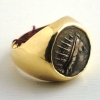
Price :
$2600.00
Origin: Rhodes
Circa: 200 BC to 100 BC
Collection: Greek Coin Ring
Style: Greek Coin Rings
Medium: Silver and Gold
The rayed head of Helios, god of the sun, appears on More »
Origin: Rhodes
Circa: 200 BC to 100 BC
Collection: Greek Coin Ring
Style: Greek Coin Rings
Medium: Silver and Gold
The rayed head of Helios, god of the sun, appears on the obverse of this ancient coin. It was colossal statue of this deity, one of the seven wonders of the ancient world, which guarded the entrance to the harbor of Rhodes. On the reverse is the rose emblem that gave the island its name. The person who first held this coin was witness to the flower of the classical age. To wear this splendid ring today is to link ourselves directly with the vanished glories of the past. - (FJ.3071) « Less
|
|
Ancient Jewelry
|
|
|
|
|
| Vendor Details |
Close |
| Contact Info : |
| Barakat Gallery |
| 405 North Rodeo Drive |
| Beverly Hills |
| California-90210 |
| USA |
| Email : barakat@barakatgallery.com |
| Phone : 310.859.8408 |
|
|
|
|
|
|
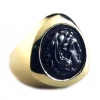
Price :
$2800.00
Origin: Israel (Samaria)
Circa: 336 BC to 323 BC
Collection: Coin Jewelry
Style: Greek
Medium: Silver/Gold
Additional Information: This superb coin is set in an 18-karat More »
Origin: Israel (Samaria)
Circa: 336 BC to 323 BC
Collection: Coin Jewelry
Style: Greek
Medium: Silver/Gold
Additional Information: This superb coin is set in an 18-karat gold ring.
Like people, no two ancient coins are ever exactly alike. Minted by hand, patinated by time, surviving by chance, each coin has a distinct personality. Beyond the beautiful images and powerful messages that speak of the rise and fall of empires, every coin has a private history, less obvious perhaps, but equally real. When we wear this gorgeous ring today, we link ourselves directly with the lives of the men and women who held this coin during Alexander’s lifetime. In doing so, we add our own unique chapter to its fascinating story. - (FJ.3359) « Less
|
|
Ancient Jewelry
|
|
|
|
|
| Vendor Details |
Close |
| Contact Info : |
| Barakat Gallery |
| 405 North Rodeo Drive |
| Beverly Hills |
| California-90210 |
| USA |
| Email : barakat@barakatgallery.com |
| Phone : 310.859.8408 |
|
|
|
|
|
|
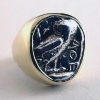
Price :
$3600.00
Origin: Greece (Island of Rhodes)
Circa: 490 BC to 322 BC
Collection: Coin Jewelry
Style: Greek
Medium: Silver-Gold
During the height of the classical world, no other More »
Origin: Greece (Island of Rhodes)
Circa: 490 BC to 322 BC
Collection: Coin Jewelry
Style: Greek
Medium: Silver-Gold
During the height of the classical world, no other Greek state rivaled Athens for power, wealth and beauty. The legacy of the Athenian golden age is still found in the institution of democracy, in drama and the arts and in the architectural wonders on the acropolis. This splendid silver tetradrachm evokes the glory and grandeur of that unique world. On the front of the coin appears the dramatic image of a helmeted Athena, the ancient Greek goddess of wisdom and war. Athena was the daughter of Zeus, king of the gods. According to myth, her father was suffering from an enormous headache and summoned Hephaistion the blacksmith god to split open his head and relieve the pain. When Hephaistion brought his hammer down on Zeus skull, Athena jumped forth fully grown and wearing a suit of armor. Although important to all the Greek people, Athena’s chief cult was at Athens, the city named for her. Legend has it that she had a contest with Poseidon, god of the sea, for control of the town. It was decided that whichever god gave the most valuable gift to the city would become its patron. Poseidon struck the earth with his trident and a salt spring came forth Athena produced the olive tree, source of ancient Athens greatest commercial wealth, and thereby won the contest. The scenes of her birth and the contest were portrayed on the pediments of the Parthenon, the temple erected in her honor on the acropolis of Athens in the 5th century B.C. On the reverse side of this Athenian coin an owl appears, the ancient symbol of wisdom--one that often accompanies the portrayal of the revered goddess of wisdom, Athena. Framed by a regal gold ring setting, one that befits such an important coin, this radiant work of art truly evidences the glory of ancient Athens, a city that continues to cast its spell upon our senses. - (FJ.4667) « Less
|
|
Ancient Jewelry
|
|
|
|
|
| Vendor Details |
Close |
| Contact Info : |
| Barakat Gallery |
| 405 North Rodeo Drive |
| Beverly Hills |
| California-90210 |
| USA |
| Email : barakat@barakatgallery.com |
| Phone : 310.859.8408 |
|
|
|
|
|
|
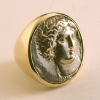
Price :
$2600.00
Circa: 354 BC to 353 BC
Collection: Greek Coin rings
Medium: Silver-Gold
Amphipolis was founded by Athens in 437 B.C. But fell under the power of the Macedonian king More »
Circa: 354 BC to 353 BC
Collection: Greek Coin rings
Medium: Silver-Gold
Amphipolis was founded by Athens in 437 B.C. But fell under the power of the Macedonian king Philip II, father of the famous Alexander the Great, in 357 B.C. From the middle of this period, the city produced a magnificent series of tetradrachms, as evidenced in this stunning silver coin. On the obverse side a stunning portrait of Apollo is depicted. As the Greek sun god Apollo was one of the twelve original Olympian gods. Born the son of Zeus on the island of Delos, he was raised by Poseidon. As well as being a solar god to the Greeks, Apollo was also the god of fine arts, medicine, music, poetry and eloquence. Both his fame and spirited powers have come down through the ages, inspiring such eloquent English authors as Milton, Shakespeare and Spencer. The reverse side of this ancient silver coin features a lighted torch which alludes to the torch races held at Amphipolis in honor of Apollo. The inscribed square band that surrounds the torch is reminiscent of the square reverse punches of archaic coinage, a motif that remained for a relatively long period of time on Macedonian coinage. Mounted in a regal gold ring, a setting that truly befits this spirited work of art, this silver tetradrachm of Amphipolis magically transports us back to an age when the Macedonians wielded an enormous amount of power and created a material culture equal in its vitality and beauty. - (FJ.5114) « Less
|
|
Ancient Jewelry
|
|
|
|
|
| Vendor Details |
Close |
| Contact Info : |
| Barakat Gallery |
| 405 North Rodeo Drive |
| Beverly Hills |
| California-90210 |
| USA |
| Email : barakat@barakatgallery.com |
| Phone : 310.859.8408 |
|
|
|
|
|
|

Price :
$3600.00
Origin: Holy Land
Circa: 336 BC to 323 BC
Collection: Greek Silver Coin Ring
Medium: Silver-Gold
The character of Alexander the Great is born fascinating and mystifying. More »
Origin: Holy Land
Circa: 336 BC to 323 BC
Collection: Greek Silver Coin Ring
Medium: Silver-Gold
The character of Alexander the Great is born fascinating and mystifying. He was brilliant, ambitious, generous, cruel, logical, a little mad and ultimately elusive. Perhaps considered a god, Alexander III, king of Macedon and later king of Persia, was the most legendary and visionary leader the world has ever known. He was born in 356 B.C., the son of Philip II of Macedon and his headstrong queen, Olympias. While Alexander w as growing up, his father was bringing Greece under Macedonian hegemony, with the ultimate goal of destroying the Persian Empire. Alexander had extensive military training, and was tutored by Aristotle. Relations between his father and mother were often strained and born Alexander and Olympias have been implicated in the assassination of Philip II in 336 B.C. At the same time, Alexander became ruler of Macedon and leader of the unified invasion force against Persia. He led his army across the Hellespont in 334 B.C. And won a series of decisive victories which led to the ultimate downfall of the Persian king, Darius III. Alexander conquered Egypt and founded the new city, Alexandria, now a great capital of antiquity. Altogether, Alexander and his army marched as far east as India and created one of the largest unified empires ever known. At the death of Alexander, his kingdom was divided among his more ambitious followers. - (FJ.5153) « Less
|
|
Ancient Jewelry
|
|
|
|
|
| Vendor Details |
Close |
| Contact Info : |
| Barakat Gallery |
| 405 North Rodeo Drive |
| Beverly Hills |
| California-90210 |
| USA |
| Email : barakat@barakatgallery.com |
| Phone : 310.859.8408 |
|
|
|
|
|
|
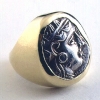
Price :
$4200.00
Origin: Mediterranean
Circa: 490 BC to 322 BC
Collection: Coin Jewelry
Style: Greek
Medium: Silver and Gold
During the height of the classical world, no other Greek More »
Origin: Mediterranean
Circa: 490 BC to 322 BC
Collection: Coin Jewelry
Style: Greek
Medium: Silver and Gold
During the height of the classical world, no other Greek state rivaled Athens for power, wealth and beauty. The legacy of the Athenian golden age is still found in the institution of democracy, in drama and the arts and in the architectural wonders on the acropolis. This splendid silver tetradrachm evokes the glory and grandeur of that unique world. On the front of the coin appears the dramatic image of a helmeted Athena, the ancient Greek goddess of wisdom and war. Athena was the daughter of Zeus, king of the gods. According to myth, her father was suffering from an enormous headache and summoned Hephaistion the blacksmith god to split open his head and relieve the pain. When Hephaistion brought his hammer down on Zeus skull, Athena jumped forth fully grown and wearing a suit of armor. Although important to all the Greek people, Athena’s chief cult was at Athens, the city named for her. Legend has it that she had a contest with Poseidon, god of the sea, for control of the town. It was decided that whichever god gave the most valuable gift to the city would become its patron. Poseidon struck the earth with his trident and a salt spring came forth Athena produced the olive tree, source of ancient Athens greatest commercial wealth, and thereby won the contest. The scenes of her birth and the contest were portrayed on the pediments of the Parthenon, the temple erected in her honor on the acropolis of Athens in the 5th century B.C. On the reverse side of this Athenian coin an owl appears, the ancient symbol of wisdom--one that often accompanies the portrayal of the revered goddess of wisdom, Athena. Framed by a regal gold ring setting, one that befits such an important coin, this radiant work of art truly evidences the glory of ancient Athens, a city that continues to cast its spell upon our senses. - (FJ.5154) « Less
|
|
Ancient Jewelry
|
|
|
|
|
| Vendor Details |
Close |
| Contact Info : |
| Barakat Gallery |
| 405 North Rodeo Drive |
| Beverly Hills |
| California-90210 |
| USA |
| Email : barakat@barakatgallery.com |
| Phone : 310.859.8408 |
|
|
|
|
|
|
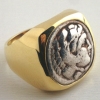
Price :
$1800.00
Circa: 336 BC to 323 BC
Collection: Greek Coin Ring
Medium: Silver-Gold
The character of Alexander the Great is born fascinating and mystifying. He was brilliant, More »
Circa: 336 BC to 323 BC
Collection: Greek Coin Ring
Medium: Silver-Gold
The character of Alexander the Great is born fascinating and mystifying. He was brilliant, ambitious, generous, cruel, logical, a little mad and ultimately elusive. Perhaps considered a god, Alexander III, king of Macedon and later king of Persia, was the most legendary and visionary leader the world has ever known. He was born in 356 B.C., the son of Philip II of Macedon and his headstrong queen, Olympias. While Alexander w as growing up, his father was bringing Greece under Macedonian hegemony, with the ultimate goal of destroying the Persian Empire. Alexander had extensive military training, and was tutored by Aristotle. Relations between his father and mother were often strained and born Alexander and Olympias have been implicated in the assassination of Philip II in 336 B.C. At the same time, Alexander became ruler of Macedon and leader of the unified invasion force against Persia. He led his army across the Hellespont in 334 B.C. And won a series of decisive victories which led to the ultimate downfall of the Persian king, Darius III. Alexander conquered Egypt and founded the new city, Alexandria, now a great capital of antiquity. Altogether, Alexander and his army marched as far east as India and created one of the largest unified empires ever known. At the death of Alexander, his kingdom was divided among his more ambitious followers. - (FJ.5171) « Less
|
|
Ancient Jewelry
|
|
|
|
|
| Vendor Details |
Close |
| Contact Info : |
| Barakat Gallery |
| 405 North Rodeo Drive |
| Beverly Hills |
| California-90210 |
| USA |
| Email : barakat@barakatgallery.com |
| Phone : 310.859.8408 |
|
|
|
|
|
|

Price :
$5000.00
Origin: Mediterranean
Circa: 350 BC
Catalogue: V12
Collection: Jewelry
Style: Greek Silver Rings
Medium: Silver and Gold
The ancient Greek colony of Thuria, located in More »
Origin: Mediterranean
Circa: 350 BC
Catalogue: V12
Collection: Jewelry
Style: Greek Silver Rings
Medium: Silver and Gold
The ancient Greek colony of Thuria, located in southern Italy, was founded in 443 B.C. Not far removed from the site of deserted Sybaris. The colony was at first called by its old name, but later the name was changed to Thuria, named after a fountain in the immediate area. A large influx of new colonists from Athens resulted in commercial prosperity for this new attic colony. The coins of Thurium rank among the finest, a purity of style and delicacy of execution resulting in masterpieces of numismatic art. This stunning silver stater features the image of a rushing bull, its legs in an animated pose. With its tail twitching in the air and head down, we can almost hear the snorting sounds emanating from the flared nostrils of this fearsome beast. The ancient symbolism of this bovine is still unclear. Some take it to be a symbol of Dionysus, others to be the rushing bull indicative of the fountain Thuria, while some see the bull as an artistic development of the bull which adorned earlier sybaritic coins. The reverse side of this stunning coin features the Greek goddess Athena. This particular portrait is that of Athena Skyletria, a sea goddess who was worshiped on the southern coasts of Brutium (Italy). Adorning Athena’s head is a helmet with the image of the ancient Greek nymph, Scylla. Legend has it that a sea deity Glaucus, fell in love with the beautiful nymph but she scorned his attention. Glaucus appealed to the goddess Circe for help; instead of helping him, Circe fell in love with Glaucus and tried to make him forget Scylla. By trickery, she then turned the lovely nymph into a frightful monster, the upper part of her body and head remaining a beautiful maiden, the lower part encircled with the necks and heads of six hideous barking dogs who, whenever a ship passed, reached out to grab six seamen and devour them. Scylla's monster body can be seen on this coin, curling about Athena’s helmet. Captivating mythological images and masterful craftsmanship combine to form a most unique coin, one that continues to cast its spell upon all who behold its radiant beauty. - (FJ.5172) « Less
|
|
Ancient Jewelry
|
|
|
|
|
| Vendor Details |
Close |
| Contact Info : |
| Barakat Gallery |
| 405 North Rodeo Drive |
| Beverly Hills |
| California-90210 |
| USA |
| Email : barakat@barakatgallery.com |
| Phone : 310.859.8408 |
|
|
|
|
|
|

Price :
$2600.00
Origin: Mediterranean
Circa: 200 BC to 100 BC
Collection: Jewelry
Style: Greek Coin Rings
Medium: Silver and Gold
Additional Information: This coin was found in Asia More »
Origin: Mediterranean
Circa: 200 BC to 100 BC
Collection: Jewelry
Style: Greek Coin Rings
Medium: Silver and Gold
Additional Information: This coin was found in Asia Minor.
This genuine ancient Greek silver coin has been mounted in a modern 18 karat gold ring. - (FJ.5175) « Less
|
|
Ancient Jewelry
|
|
|
|
|
| Vendor Details |
Close |
| Contact Info : |
| Barakat Gallery |
| 405 North Rodeo Drive |
| Beverly Hills |
| California-90210 |
| USA |
| Email : barakat@barakatgallery.com |
| Phone : 310.859.8408 |
|
|
|
|
|
|
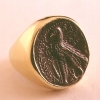
Price :
$2600.00
Origin: Egypt
Circa: 146 BC to 140 BC
Collection: Coin Jewelry
Style: Greek
Medium: Silver, Gold
Additional Information: The coin was found in Israel.
The elder son of More »
Origin: Egypt
Circa: 146 BC to 140 BC
Collection: Coin Jewelry
Style: Greek
Medium: Silver, Gold
Additional Information: The coin was found in Israel.
The elder son of Demetrius I Soter, Demetrius II was put on the throne of the Seleucid Empire after the overthrow of the usurper Alexander Balas. He was married to Cleopatra Thea, who had been the wife of balas and was later to marry Demetrius' brother Antiochus vii while Demetrius was held captive in Parthia. The first reign of Demetrius was marred by civil war which this boy king could do little to stop. At the age of twenty he began a series of military campaigns against the powerful Parthian empire, and though he met with some success, in 140 he was taken prisoner and sent to the Parthian court, where he remained for ten years as a hostage. In 129 B.C., Demetrius II was released from captivity in the hope that his asserting his right to the Seleucid throne would cause a civil war and divert the attention of the army away from a Parthian campaign. The death of his brother Antiochus VII left Demetrius, unexpectedly, the sole ruler with Cleopatra Thea once more as his queen. His second reign was not much more successful than the first. Revolt broke out with numerous pretenders claiming power. After being defeated in battle near Damascus in 125, Demetrius was killed on orders from his wife, who then assumed power herself.This stunning coin, struck during the first reign of Demetrius II, features the regal image of an eagle on one side, while the other side depicts the diademed head of Demetrius II. Framed in a radiant gold ring, this striking coin is an emblem of the character and imagination of this exciting period in ancient Seleucid history. - (FJ.5178) « Less
|
|
Ancient Jewelry
|
|
|
|
|
| Vendor Details |
Close |
| Contact Info : |
| Barakat Gallery |
| 405 North Rodeo Drive |
| Beverly Hills |
| California-90210 |
| USA |
| Email : barakat@barakatgallery.com |
| Phone : 310.859.8408 |
|
|
|
|
|
|
|
|

|


